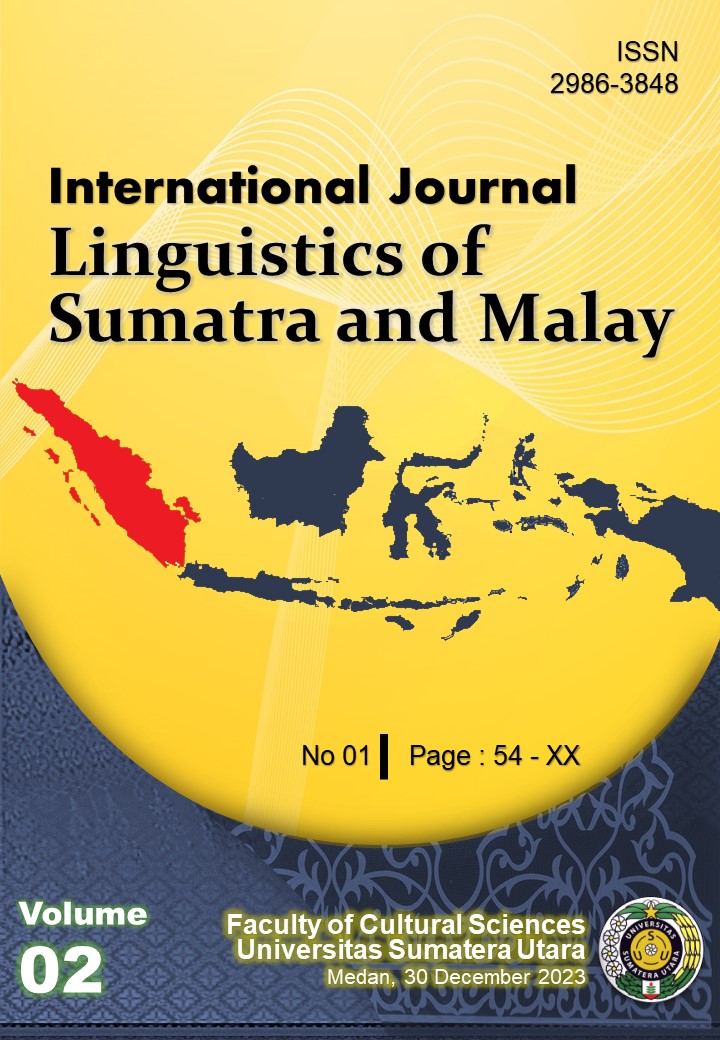Indonesian Local Literary Rituals in Magical Realism
DOI:
https://doi.org/10.32734/ijlsm.v2i1.14367Keywords:
Art performance, Realism magis, Local Literary Rituals, BantenganAbstract
This study aims to find magical realism in the Bantengan performance, find namely the irreducible elements, the phenomenal world, merging realms, the unsettling doubts, and disruptions of time, space, and identity at the Bantengan show. The method used to reveal these aspects is a qualitative method with an ethnographic approach. Theoretically, this research finds magical realism. Practically for researchers, this research is expected to broaden scientific horizons and can be used as a guide to carry out research, especially about traditions that develop in society. For the community, this research is expected to provide an overview of the actual Bantengan performance and provide knowledge to the public that the art of Bantengan contains the meaning of a performance that contains the value of magical realism. The results of this study: 1. The irreducible elements namely Cakepan in the art of bantengan are read as if telling the figure of a bull in the performance arena, furthermore it is used as advice and a medium for conveying messages to the public. 2. the phenomenal world, namely the movements in the Banteng symbolizing the life of the Banteng animal as an authoritative and strong base or forest animal, 3. merging realms, namely between types of religious magical beliefs and Islam there is a harmonious blend, as seen by the reading of prayers that derived from the verses of the Koran at the ceremony, 4. the unsettling doubts, namely the public's belief is still visible in the giving of offerings or offerings before holding a bantengan presentation, 5. disruptions of time, space and identity namely Bantengan and ndadi being one of the elements of the show that cannot be separated, so that it becomes a special attraction for the community.
Downloads
References
Ahimsa-Putra, H. S. (2019). Language, literature, and local wisdom in Indonesia. Breaking Up. https://doi.org/10.26499/mab.v3i1.115
Asga, H. (2014). Magical Realism in the Short Story Arajang by Khrisna Pabichara: The Concept of Characteristics of Magical Realism by Wendy B. Faris. Yogyakarta: Gadjah Mada University.
Asmida, E. (2020). Magical Realism in Audrey Niffenegger's The Time Traveler's Wife. Eralingua: Journal of Foreign Language and Literature Education. https://doi.org/10.26858/eralingua.v4i1.11891
Baker, A. (2010). Characteristics of magical realism: One Hundred Years of Solitude and Spirits in the House. Retrieved May 10, 2011, from http://anayambaker.hubpages.com
Bartes, R. (1962). Reviews of books and periodicals / Chronique bibliographique: A propos de deux ouvrages récents de Cl. Levi-Strauss. Social Science Information. https://doi.org/10.1177/053901846200100410
Bird, J. (2020). More than words: Performance ethnography as a research method that values sustained ethnographic orientation and imaginative theatremaking. International Journal of Education & the Arts, 21(22).
Christopher, W. (2009). Magical Realism and the Postcolonial Novel (Between Faith and Irreverence) New York: Palgrave Macmillan
Couldry, N. (2005). Media Rituals; Beyond Functionalism. In E. W. Rothenbuhler & M. Coman (Eds.), Media Anthropology. Thousand Oaks: SAGE Publications.
Daiches, D. (1961). A Critical History of English Literature. London: Martin Secker & Warburg Ltd.
Easy. (2016). Magical Realism in Ahmad Sa'dawiy's Frankenstein fi Baghdad. Humanities, 28(2), 142-151.
Fang, L. Y. (2016). History of Classical Malay Literature. Jakarta: Indonesia Torch Foundation.
Faris, W. B. (2004). Ordinary Enchantments Magical Realism and the Remystification of Narrative. Nashville: Vanderbilt University Press.
Faruk, D., Dewojati, C., Mashur, F. M., & Anwar, A. S. (2020). Magical Realism at the Ciamis Darussalam Islamic Boarding School. Cultural Service Journal, 3(1), 20-29.
Gapur, A., Baiquni, R., & Pujiono, M. (2018). Tunda-Tunda Bamban Dalam Kebudayaan Masyarakat Melayu Tamiang di Aceh (Analisis Wacana Teks, Koteks, dan Konteks). ETNOSIA : Jurnal Etnografi Indonesia, 3(2), 141. https://doi.org/10.31947/etnosia.v3i2.3617
Geetha, B. J. (2010). Magic realism in Gabriel Garzia Marquez's One Hundred Years of Solitude. Rupkatha Journal on Interdisciplinary Studies in Humanities, 2(3), 201-210.
Hart, S. M., & Ouyang, W.-C. (2005). A Companion to Magical Realism. New York: Tamesis.
Hegerfeldt, A. C. (2005). Lies that Tell the Truth Magical Realism Seen Through Contemporary Fiction from Britain. New York: Rodopi BV.
Marquez, G. G. (1993). Light is Like Water. In Strange Pilgrims. New York: Alfred A. Knopf, Inc.
Marquez, G. G. (2003). One Hundred Years of Solitude. Yogyakarta: Cultural Landscape.
Ogunba, O. (2000). Stage and Staging in Yoruba Ritual Drama. In L. D. Sidney (Ed.), African Theater in Performance. Australia: Harwood Academic Publishers.
Ogundeji, A. (2000). Ritual as Theatre, Theater as Ritual: The Nigerian Example. Ibadan: Kraft Books.
Praise, H. (2017). Magical Realism as a Strategy for the Existence of Myth Collectors in the Hierarchical Space of Indonesian Literature. In U. Sumiman (Ed.), Literacy, Literature and Its Teaching: Proceedings of the National Seminar, HISKI Southeast Sulawesi, Kendari: 29-30 April 2017 (pp. 130-141). Kendari: Faculty of Cultural Sciences, Halu Oleo University.
Ricklefs, M. C. (1984). Islamization in Java. In R. Israeli & A. H. Johns (Eds.), Islam in Asia Volume II Southeast and East Asia. Jerusalem: The Magnes Press, The Hebrew University.
Rothenbuhler, E. W. (1998). Ritual Communication: From Everyday Conversation to Mediated Ceremony. Thousand Oaks: SAGE Publications.
Royce, A. P. (2007). Anthropology of Dance. Bandung: Publisher Sunan Ambu PRESS STSI Bandung.
Schechner, R. (1993). The Future of Ritual: Writings on Culture and Performance. London: Routledge.
Septiana, R. (2015). Magical Realism and the Erasure of the Worlds in Yann Martel's Life of Pi in Postmodernism Perspective. Jember: University of Jember.
Setiawan, I. (2012). The Melting of Power: Literature, Liquid Subjectivity, and Resistance to the Powers of Culture and the State in a Postcolonial Perspective. Jentera: Journal of Literary Studies, 1(1), 1–11.
Smith, L. B. (1988). This Realm of England 1399 to 1688. Toronto: DC Heath and Company.
Soyinka, W. (1976). Myth, Literature and African World. Cambridge: Cambridge University Press.
Spradley, J. (1998). The Ethnographic Interview (from Spradley, 1979). Introduction to Qualitative Methods.
Thamarana, S. (2015). Magic Realism in English Literature and its Significant Contribution. International Journal of English Language, Literature and Translation Studies (Ijelr), 2(4), 263—266.
Tom, J. L. (1999). Magical Realism, Freedom, and Control in Garcia Marquez, Millhauser, and Winterson (Master's thesis). San Jose Satet University, USA.
Watt, I. (1986). The Rise of the Novel: Studies on Defoe, Richardson, and Fielding. California: University of California Press.
Yerima, A. (2007). Theatre, Culture and Politics: Essays in Dramatic and Cultural Theory. Lagos: Concept Publications Limited.
Young, D. (2006). David Young: Producing uncertainty. In Contemporary Music Review. https://doi.org/10.1080/07494460600761070
Downloads
Published
Issue
Section
License
Copyright (c) 2023 International Journal Linguistics of Sumatra and Malay

This work is licensed under a Creative Commons Attribution-ShareAlike 4.0 International License.
All articles published in the International Journal Linguistics of Sumatra and Malay (IJLSM) are licensed under the Creative Commons Attribution-ShareAlike 4.0 International License (CC BY-SA 4.0).
This license permits anyone to:
-
Share — copy and redistribute the material in any medium or format.
-
Adapt — remix, transform, and build upon the material for any purpose, even commercially.









